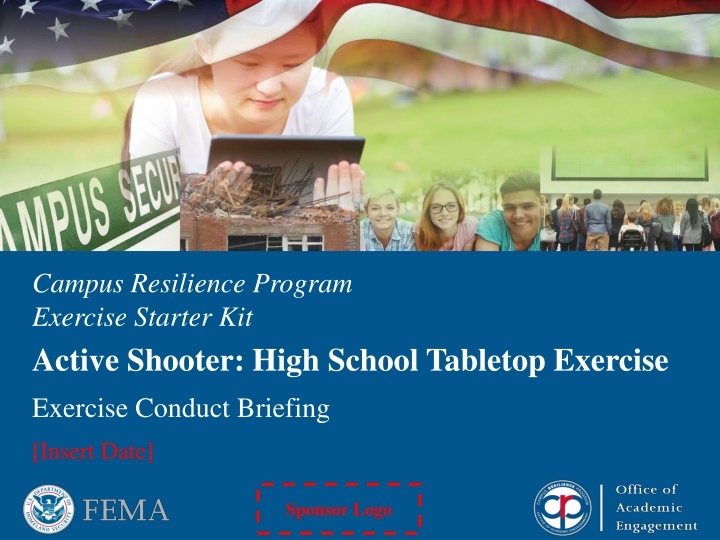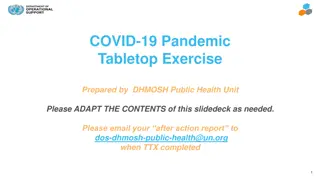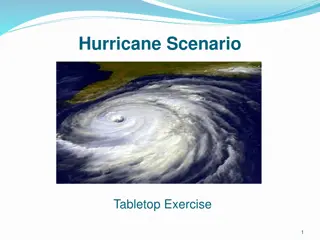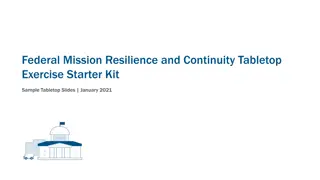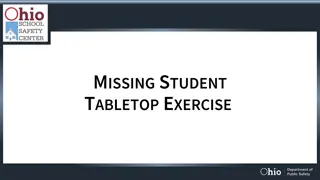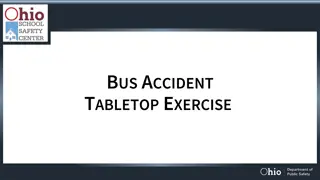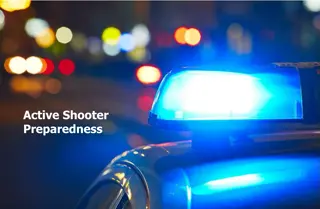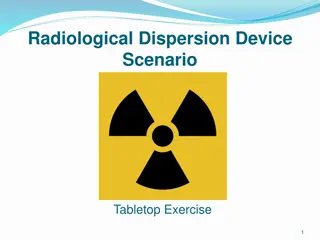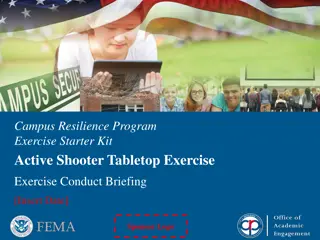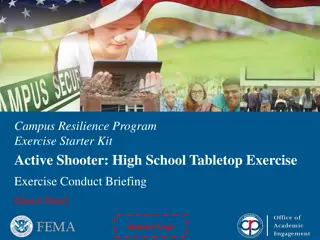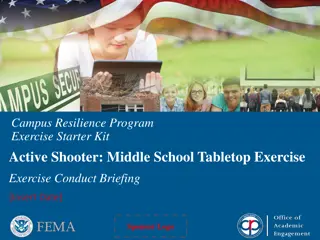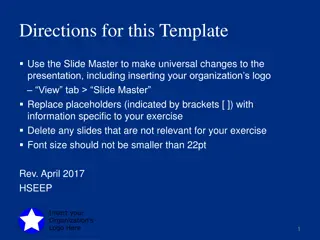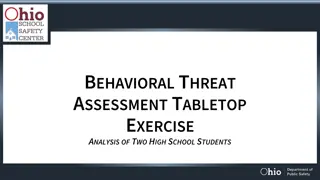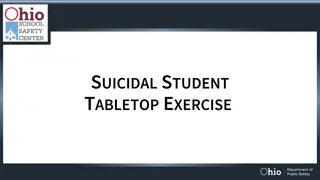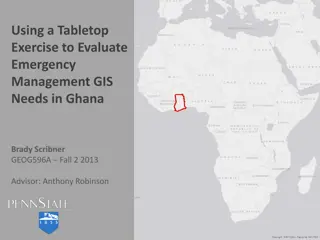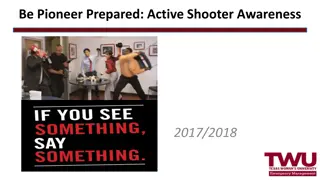High School Tabletop Exercise Briefing for Active Shooter Situation
This briefing document is designed as a baseline exercise for High Schools to assess their emergency plans and procedures regarding an active shooter incident. It provides a sample structure that can be customized by filling in highlighted red brackets. The document should be used alongside the Active Shooter: High School Situation Manual and Facilitator Guide to ensure alignment. The Exercise Conduct Briefing covers welcome and introductions, administrative remarks, exercise schedule, and exercise overview. It aims to enhance preparedness and resilience within the school community.
Download Presentation

Please find below an Image/Link to download the presentation.
The content on the website is provided AS IS for your information and personal use only. It may not be sold, licensed, or shared on other websites without obtaining consent from the author.If you encounter any issues during the download, it is possible that the publisher has removed the file from their server.
You are allowed to download the files provided on this website for personal or commercial use, subject to the condition that they are used lawfully. All files are the property of their respective owners.
The content on the website is provided AS IS for your information and personal use only. It may not be sold, licensed, or shared on other websites without obtaining consent from the author.
E N D
Presentation Transcript
Campus Resilience Program Exercise Starter Kit Active Shooter: High School Tabletop Exercise Exercise Conduct Briefing [Insert Date] Sponsor Logo Sponsor Logo
READ FIRST The purpose of this Exercise Conduct Briefing is to provide a baseline exercise document that High Schools can use to assess their emergency plans, policies, and procedures The sample content contained in this document can be tailored as necessary by filling in all [bracketed content that is highlighted in red] To insert the sponsoring organization s logo, navigate to the View menu and select Slide Master This briefing is to be used in tandem with the Active Shooter: High School Situation Manual and Facilitator Guide so any changes made to this briefing will need to be aligned with those documents **Delete slide prior to conduct**
Welcome and Introductions [Name] [Title] [Department/Agency/Organization] [Name] [Title] [Department/Agency/Organization] Sponsor Logo 3
Administrative Remarks Cell phone etiquette Evacuation procedures Restroom locations Sponsor Logo 4
Exercise Schedule Activity [Welcome and Introductions] [Exercise Overview] Module 1: Initial Response Break Module 2: Continued Response Break Module 3: Short-Term Recovery [Exercise Hot Wash] [Closing Remarks] Time [00:00 a.m.] [00:00 a.m.] [00:00 a.m.] [00:00 a.m.] [00:00 p.m.] [00:00 p.m.] [00:00 p.m.] [00:00 p.m.] [00:00 p.m.] Sponsor Logo 5
Exercise Overview Sponsor Logo 6
Exercise Overview Background: This Tabletop Exercise (TTX) is made available through the Campus Resilience Program (CR Program) Exercise Starter Kits Each Exercise Starter Kit aims to support practitioners and senior leaders from the High School academic community in assessing emergency plans, policies, and procedures while also enhancing overall school resilience Purpose: This specific Exercise Starter Kit will provide the opportunity to examine response and recovery operations related to an active shooter incident Sponsor Logo 7
Exercise Overview (cont.) Scope: This [insert duration]-TTX is divided into three Modules: Module 1 will examine initial response operations to an active shooter incident Module 2 will examine continued response operations to an active shooter incident Module 3 will examine short-term recovery operations following an active shooter incident Each Module will consist of two activities: 1. Scenario Overview: Each Module will contain a detailed overview of the scenario 2. Facilitated Discussions: Participants will engage in facilitated discussions surrounding a set of discussion questions Sponsor Logo 8
READ FIRST The exercise objectives contained in the following slide(s) are provided as sample objectives These can be tailored as appropriate to align with the overarching goals and desired outcomes for the exercise Please note that changes made to these objectives will need to be reflected in the associated Facilitator Guide and Situation Manual for this scenario **Delete slide prior to conduct**
Exercise Objectives 1. Operational Coordination: Assess the ability to establish an effective command structure that integrates all critical stakeholders to ensure school and community resources are used efficiently to respond to and recover from an active shooter incident. On-Scene Security, Protection, and Law Enforcement: Evaluate the ability to provide a safe and secure environment for students and staff, as well as first responders, during the response to an active shooter incident occurring on school grounds. Mass Care Services: Examine processes and procedures to provide and coordinate mass care services to include life-sustaining, human services, and Psychological First Aid for Schools (PFA-S) during the response to and recovery from an active shooter incident. Public Information and Warning: Assess the ability to deliver coordinated, actionable, age-appropriate, and timely information to critical partners and stakeholders when faced with an active shooter incident. Community Resilience: Assess recovery plans that capture expectations, priorities, and actions of students, staff, families, and the community in the aftermath of an active shooter incident. 2. 3. 4. 5. Sponsor Logo 10
Participant Roles and Responsibilities Facilitator: Provides situation updates and facilitates discussions Players: Responds to the situation presented based on current plans, policies, and procedures Observers: Visits or views selected segments of the exercise without directly engaging in exercise discussions Support Staff: Performs administrative and logistical support during the exercise (e.g., registration) [Insert additional participant roles as appropriate] Sponsor Logo 11
Participating Organizations [Insert Participating Organization] [Insert Participating Sub-Organization] [Insert Participating Organization] [Insert Participating Sub-Organization] [Insert Participating Organization] [Insert Participating Sub-Organization] Sponsor Logo 12
Exercise Guidelines This exercise is being conducted in an open, low-stress, no-fault environment; varying viewpoints, even disagreements, are expected Act in real-world roles for your school or organization when considering the scenario Decisions are not precedent-setting; this is an open discussion The focus should be on identifying suggestions and recommended actions for improving preparedness, response, and recovery efforts [Insert any additional guidelines that may be relevant to the exercise] Sponsor Logo 13
Assumptions and Artificialities The exercise scenario is plausible and events occur as they are presented Players will use existing plans, policies, procedures, and resources to guide responses There is no hidden agenda nor are there any trick questions The scenario assumes certain player actions as it moves through each phase; players should first discuss the actions stipulated by the scenario Players are welcome to engage in what if discussions to alternative scenario conditions [Insert any additional assumptions or artificialities that may be relevant to the exercise] Sponsor Logo 14
Start of Exercise Sponsor Logo 15
Module 1: Initial Response Sponsor Logo 16
Scenario Background It is a few days before homecoming; students and staff are preparing for a rally for your school s sports team Decorations are being put up in the auditorium and the band is practicing outside in the sports fields A student notifies a teacher that another student has posted disturbing messages on social media about wanting to hurt students and teachers at your school Sponsor Logo 17
Module 1: Scenario Overview [Insert Date and Time] Two hours later, an unidentified individual enters [insert school name] and opens fire in classrooms on the first floor Bystanders begin fleeing from the [insert building name] and disperse in all directions Students and staff in other classrooms turn off lights and barricade doors The gunman leaves the first floor and proceeds to the second floor; the sound of popping noises and screaming continues sporadically Sponsor Logo 18
Module 1: Scenario Overview (cont.) Local 9-1-1 operators receive frantic calls reporting popping noises, screaming, and flashes of light Students begin posting on social media about their experience, and some students begin to flee [The school resource officer hears shots coming from an upper floor, she encounters the gunman and is wounded before calling for backup] First responders arrive on the scene Sponsor Logo 19
Module 1: Discussion Questions (1/4) Operational Coordination 1. What plans, policies, and procedures does your school have in place to respond to an active shooter event? 2. What are your school s initial priorities? 3. How would your school establish a command structure to coordinate your immediate response efforts? 4. What resource gaps could limit your school s ability to respond to an active shooter? 5. [Insert additional discussion questions as appropriate] Sponsor Logo 20
Module 1: Discussion Questions (2/4) On-Scene Security, Protection, and Law Enforcement 1. In terms of securing the scene, what are the immediate priorities? 2. Given the situation, what protective measures would you adopt at this point, if any? 3. How would resource needs be prioritized in the event of a secondary attack? 4. Have you trained or exercised with your local first responders? 5. [Insert additional discussion questions as appropriate] Sponsor Logo 21
Module 1: Discussion Questions (3/4) Mass Care Services 1. What are your school s immediate mass care priorities? 2. What partners would you begin to coordinate with at this point? 3. What critical decisions might need to be made at this point? 4. [Insert additional discussion questions as appropriate] Sponsor Logo 22
Module 1: Discussion Questions (4/4) Public Information and Warning 1. How does your school issue warnings, alerts, and other emergency messaging? 2. What plans, policies, and procedures does your school have in place to guide your internal and external communications strategies? 3. What individual (or position) coordinates and delivers your school s public messaging? 4. How does your school encourage students, staff, and families to take individual steps to prepare for a potential active shooter incident? 5. [Insert additional discussion questions as appropriate] Sponsor Logo 23
Break Sponsor Logo 24
Module 2: Continued Response Sponsor Logo 25
Module 2: Scenario Overview [Insert Date and Time + 15 Minutes] Local law enforcement officials arrive on scene within minutes of the first emergency call Police quickly enter the building while the local special weapons and tactics (SWAT) team begins their response The shooter barricades himself inside a stairwell; upon seeing SWAT officers, the gunman fatally shoots himself Sponsor Logo 26
Module 2: Scenario Overview (cont.) [Insert Date and Time + 1 Hour] National and local media outlets begin providing coverage of the shooting Rumors start on social media that there are multiple shooters and multiple shooting locations Parents begin arriving at the school and inundating the school with calls, voicing concern for their children Many students begin to flee on foot, in their vehicles, and on bikes Sponsor Logo 27
Module 2: Discussion Questions (1/4) Operational Coordination 1. What plans, policies, and procedures does your school have in place to guide response efforts at this point? 2. How would your school maintain an effective command structure to coordinate emergency response efforts? 3. How do key decision-makers collect information to assess the extent of the situation, including injuries and fatalities? 4. What resources are currently available? 5. Who are the key external partners that would support response efforts? 6. [Insert additional discussion questions as appropriate] Sponsor Logo 28
Module 2: Discussion Questions (2/4) On-Scene Security, Protection, and Law Enforcement 1. What response plans and protocols would your school activate at this point? 2. How will students and staff know when the school is safe and the scene is secure? 3. What additional protective measures would be implemented at this time based on your earlier decision to either evacuate, shelter-in-place, or lock-down the school? 4. How would you begin to conduct personnel accountability for students and staff? 5. [Insert additional discussion questions as appropriate] Sponsor Logo 29
Module 2: Discussion Questions (3/4) Mass Care Services 1. What potential mass care challenges does this type of incident pose for emergency managers and law enforcement response personnel? 2. How would your school address challenges of injured students and staff both on-scene and those fleeing away from the scene? 3. Does your school have a family reunification plan in place? 4. [Insert additional discussion questions as appropriate] Sponsor Logo 30
Module 2: Discussion Questions (4/4) Public Information and Warning 1. How does your school ensure consistent, coordinated public messaging throughout this phase of response operations? 2. How does your school ensure timely and accurate situational updates for internal and external partners throughout the response period? 3. Does your school have a crisis communications plan? If so, how and when is it activated? 4. How does your school notify families, key partners, and the public of fatalities or serious injuries? 5. [Insert additional discussion questions as appropriate] Sponsor Logo 31
Break Sponsor Logo 32
Module 3: Short-Term Recovery Sponsor Logo 33
Module 3: Scenario Overview [Insert Date and Time + 4 Hours] Law enforcement confirm that the threat is neutralized Injured victims are transported to healthcare facilities and hospitals Initial estimates indicate there are approximately [number] dead and [number] injured Family reunification protocols have been implemented Local and national media continue to cover the shooting and students post on social media that they are worried about returning to school Sponsor Logo 34
Module 3: Discussion Questions (1/5) Operational Coordination 1. How does your school coordinate the transition from response to short- term recovery efforts? 2. What plans, policies, and procedures guide your school s recovery process? 3. What resource gaps could limit your school s ability to meet these priorities? 4. [Insert additional discussion questions as appropriate] Sponsor Logo 35
Module 3: Discussion Questions (2/5) On-Scene Security, Protection, and Law Enforcement 1. What plans or procedures are in place to manage and secure the scene following the incident? 2. What partners would be engaged to assist with these efforts? 3. What is your process for tracking the status and location of individuals who have been injured or fatally wounded? 4. [Insert additional discussion questions as appropriate] Sponsor Logo 36
Module 3: Discussion Questions (3/5) Mass Care Services 1. What are your school s mass care recovery priorities at this point? 2. How does your school handle the notification of death or injury to relatives? 3. What plans or policies are in place to support affected populations with counseling and behavioral health resources? 4. What additional resources, if any, would be needed to support family reunification and other support services for families, students, and staff? 5. [Insert additional discussion questions as appropriate] Sponsor Logo 37
Module 3: Discussion Questions (4/5) Public Information and Warning 1. How does your school ensure consistent, coordinated public messaging throughout the recovery period? 2. How does your school provide internal and external partners with timely updates concerning recovery efforts? With families, students, staff, and alumni? 3. Do your recovery communications methods include the capability to communicate with students and staff who have language or access and functional needs requirements? 4. [Insert additional discussion questions as appropriate] Sponsor Logo 38
Module 3: Discussion Questions (5/5) Community Resilience 1. Has your school and your community thought about the aftermath of this type of incident and what the priorities, needs, and expectations are of the students, staff, families, and community? 2. Does your school have the ability to support long-term behavioral health needs for students and staff? If not, are there public or private resources that can support these requirements? 3. What actions, if any, have been identified to help the community heal? 4. [Insert additional discussion questions as appropriate] Sponsor Logo 39
End of Exercise Sponsor Logo 40
Exercise Hot Wash Sponsor Logo 41
Exercise Hot Wash This Hot Wash aims to capture the following information based on observations made throughout the exercise: Overall strengths Overall areas for improvement Major takeaways and action items Sponsor Logo 42
Closing Remarks [Name] [Title] [Department/Agency/Organization] [Name] [Title] [Department/Agency/Organization] Sponsor Logo 43
Adjournment Sponsor Logo 44
Campus Resilience Program Exercise Starter Kit Active Shooter: High School Tabletop Exercise Exercise Conduct Briefing [Insert Date] Sponsor Logo Sponsor Logo
